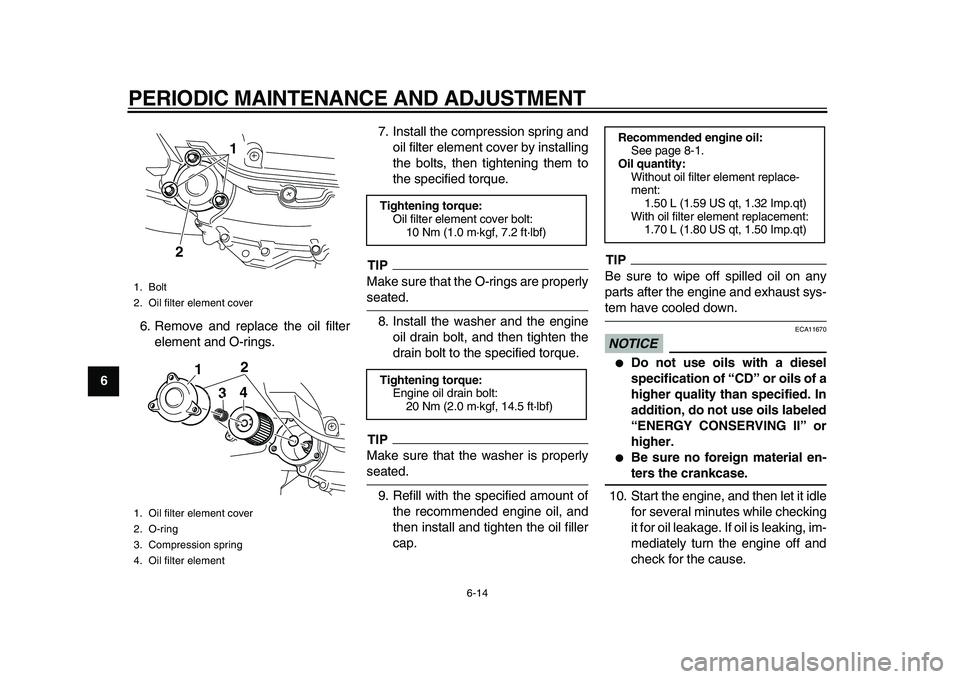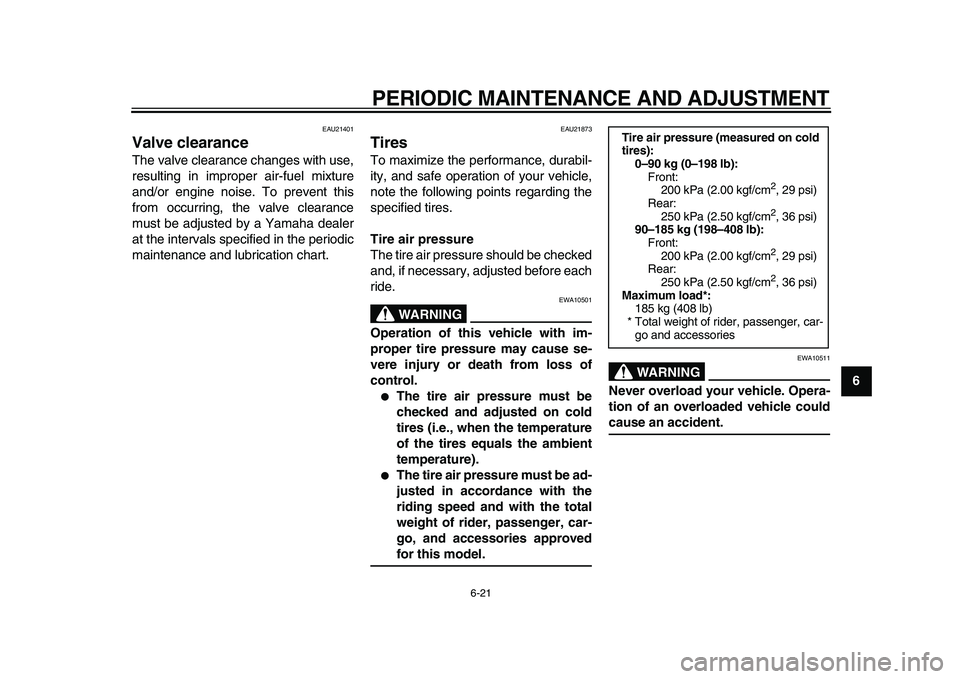Page 58 of 96

PERIODIC MAINTENANCE AND ADJUSTMENT
6-14
1
2
3
4
5
6
7
8
9
6. Remove and replace the oil filter
element and O-rings.7. Install the compression spring and
oil filter element cover by installing
the bolts, then tightening them to
the specified torque.
TIP
Make sure that the O-rings are properly
seated.
8. Install the washer and the engine
oil drain bolt, and then tighten the
drain bolt to the specified torque.
TIP
Make sure that the washer is properly
seated.
9. Refill with the specified amount of
the recommended engine oil, and
then install and tighten the oil filler
cap.
TIP
Be sure to wipe off spilled oil on any
parts after the engine and exhaust sys-
tem have cooled down.
NOTICE
ECA11670
�
Do not use oils with a diesel
specification of “CD” or oils of a
higher quality than specified. In
addition, do not use oils labeled
“ENERGY CONSERVING II” or
higher.
�
Be sure no foreign material en-
ters the crankcase.
10. Start the engine, and then let it idle
for several minutes while checking
it for oil leakage. If oil is leaking, im-
mediately turn the engine off and
check for the cause.
1. Bolt
2. Oil filter element cover
1. Oil filter element cover
2. O-ring
3. Compression spring
4. Oil filter element
21
1
2
3
4
Tightening torque:
Oil filter element cover bolt:
10 Nm (1.0 m·kgf, 7.2 ft·lbf)
Tightening torque:
Engine oil drain bolt:
20 Nm (2.0 m·kgf, 14.5 ft·lbf)
Recommended engine oil:
See page 8-1.
Oil quantity:
Without oil filter element replace-
ment:
1.50 L (1.59 US qt, 1.32 Imp.qt)
With oil filter element replacement:
1.70 L (1.80 US qt, 1.50 Imp.qt)
Page 59 of 96

PERIODIC MAINTENANCE AND ADJUSTMENT
6-15
2
3
4
5
67
8
9
11. Reset the oil change indicator ac-
cording to the following procedure.
To reset the oil change indicator
1. Turn the key to “ON”.
2. Hold the “OIL CHANGE” button
pushed for two to eight seconds.
3. Release the “OIL CHANGE” but-
ton, and the oil change indicator
will go off.
TIP
If the engine oil is changed before the
oil change indicator comes on (i.e. be-
fore the periodic oil change interval has
been reached), the indicator must be
reset after the oil change for the next
periodic oil change to be indicated atthe correct time. To reset the oil change
indicator before the periodic oil change
interval has been reached, follow the
above procedure, but note that the indi-
cator will come on for 1.4 seconds after
releasing the “OIL CHANGE” button,
otherwise repeat the procedure.
EAU20064
Final transmission oil
The final transmission case must be
checked for oil leakage before each
ride. If any leakage is found, have a
Yamaha dealer check and repair the
scooter. In addition, the final transmis-
sion oil must be changed as follows at
the intervals specified in the periodic
maintenance and lubrication chart.
1. Start the engine, warm up the final
transmission oil by riding the
scooter for several minutes, and
then stop the engine.
2. Place the scooter on the center-
stand.
3. Place an oil pan under the final
transmission case to collect the
used oil.
4. Remove the final transmission oil
filler cap and final transmission
drain bolt to drain the oil from the fi-
nal transmission case.
1.“OIL CHANGE” button
1
Page 60 of 96

PERIODIC MAINTENANCE AND ADJUSTMENT
6-16
1
2
3
4
5
6
7
8
9
5. Install the final transmission oil
drain bolt, and then tighten it to the
specified torque.
6. Refill with the specified amount of
the recommended final transmis-
sion oil, and then install and tighten
the oil filler cap.
WARNING! Make
sure that no foreign material en-
ters the final transmission case.
Make sure that no oil gets on the
tire or wheel.
[EWA11311]
7. Check the final transmission case
for oil leakage. If oil is leaking,
check for the cause.
EAU20070
Coolant
The coolant level should be checked
before each ride. In addition, the cool-
ant must be changed at the intervals
specified in the periodic maintenance
and lubrication chart.
EAU34193
To check the coolant level
1. Place the vehicle on a level sur-
face and hold it in an upright posi-
tion.
TIP
�
The coolant level must be checked
on a cold engine since the level
varies with engine temperature.
�
Make sure that the vehicle is posi-
tioned straight up when checking
the coolant level. A slight tilt to the
side can result in a false reading.
2. Pull up the right floorboard mat as
shown.
1. Final transmission oil filler cap
2. Final transmission oil drain bolt
Tightening torque:
Final transmission oil drain bolt:
20 Nm (2.0 m·kgf, 14.5 ft·lbf)
2
1
Recommended final transmission
oil:
See page 8-1.
Oil quantity:
0.25 L (0.26 US qt, 0.22 Imp.qt)
Page 61 of 96

PERIODIC MAINTENANCE AND ADJUSTMENT
6-17
2
3
4
5
67
8
9
3. Remove the coolant reservoir cov-
er by removing the screw.
4. Check the coolant level in the cool-
ant reservoir.
TIP
The coolant should be between the
minimum and maximum level marks.
5. If the coolant is at or below the
minimum level mark, open the
coolant reservoir cap, add coolant
to the maximum level mark, and
then close the coolant reservoir
cap.
WARNING! Remove only
the coolant reservoir cap. Never
attempt to remove the radiator
cap when the engine is
hot.
[EWA15161]
NOTICE:
If coolant is
not available, use distilled water
or soft tap water instead. Do not
use hard water or salt water
since it is harmful to the engine.
If water has been used instead
of coolant, replace it with cool-
ant as soon as possible, other-
wise the cooling system will not
be protected against frost and
corrosion. If water has been
added to the coolant, have a
Yamaha dealer check the anti-
freeze content of the coolant as
soon as possible, otherwise the
effectiveness of the coolant willbe reduced.
[ECA10472]
6. Install the coolant reservoir cover
by installing the screw.
7. Place the right floorboard mat in
the original position.
1. Right floorboard mat
1. Screw
2. Coolant reservoir cover
1
1
2
1. Minimum level mark
2. Maximum level mark
3. Coolant reservoir cap
Coolant reservoir capacity (up to the
maximum level mark):
0.32 L (0.34 US qt, 0.28 Imp.qt)
1
2
3
Page 62 of 96
PERIODIC MAINTENANCE AND ADJUSTMENT
6-18
1
2
3
4
5
6
7
8
9
EAU34206
Air filter elements and check
hoses and V-belt case air filter
element
The air filter elements and the V-belt
case air filter element should be ser-
viced at the intervals specified in the
periodic maintenance and lubrication
chart. Service all air filter elements
more frequently if you are riding in un-
usually wet or dusty areas.
Replacing the air filter elements
1. Place the scooter on the center-
stand.
TIP
Continue as follows for each air filter el-
ement.
2. Remove the air filter case cover by
removing the rubber caps and
screws.
Left
Right
3. Pull the air filter element out.
Left
Right
4. Insert a new air filter element into
the air filter case.
5. Install the air filter case cover by in-
1. Screw
2. Air filter case cover
3. Rubber cap
1. Screw
2. Air filter case cover
3. Rubber cap1
21
13
3
1
1
23
1. Air filter element
1. Air filter element
1
1
Page 63 of 96

PERIODIC MAINTENANCE AND ADJUSTMENT
6-19
2
3
4
5
67
8
9
stalling the screws.
NOTICE:
Make sure that each filter ele-
ment is properly seated in its
case. Always replace both air fil-
ter elements at the same time,
otherwise poor engine perfor-
mance or damage to the engine
may result. The engine should
never be operated without the
filter elements installed, other-
wise the piston(s) and/or cylin-
der(s) may become excessively
worn.
[ECA12923]
6. Install the rubber cap.
To clean the air filter check hoses
1. Check the hose at the bottom of
both air filter cases for accumulat-
ed dirt or water.
Left
Right
2. If dirt or water is visible, remove
the hose, clean it, and then install
it.
Cleaning the V-belt case air filter el-
ement
1. Remove cowling E. (See
page 6-7.)
2. Remove panel A. (See page 6-7.)
3. Remove the left air filter case cov-
er.
4. Remove the V-belt air filter case
cover by removing the screws.
5. Remove the V-belt case air filter
element by removing the screws.
1. Air filter check hose
1. Air filter check hose
1
1
1. Screw
2. V-belt air filter case cover
2
111
Page 64 of 96
PERIODIC MAINTENANCE AND ADJUSTMENT
6-20
1
2
3
4
5
6
7
8
9
6. Lightly tap the V-belt case air filter
element to remove most of the
dust and dirt, and then blow out the
dirt with compressed air as shown.
7. Check the V-belt case air filter ele-
ment for damage and replace it ifnecessary.
8. Install the V-belt case air filter ele-
ment by installing the screws.
NOTICE:
Make sure that the
V-belt filter element is properly
seated in its case.
[ECA12941]
9. Install the V-belt air filter case cov-
er by installing the screws.
10. Install the left air filter case cover.
11. Install the panel.
12. Install the cowling.
EAU21382
Checking the throttle cable
free play
The throttle cable free play should mea-
sure 3.0–5.0 mm (0.12–0.20 in) at the
throttle grip. Periodically check the
throttle cable free play and, if neces-
sary, have a Yamaha dealer adjust it.
1. Screw
2. V-belt case air filter element
2
1 1
1. Throttle cable free play
1
Page 65 of 96

PERIODIC MAINTENANCE AND ADJUSTMENT
6-21
2
3
4
5
67
8
9
EAU21401
Valve clearance
The valve clearance changes with use,
resulting in improper air-fuel mixture
and/or engine noise. To prevent this
from occurring, the valve clearance
must be adjusted by a Yamaha dealer
at the intervals specified in the periodic
maintenance and lubrication chart.
EAU21873
Tires
To maximize the performance, durabil-
ity, and safe operation of your vehicle,
note the following points regarding the
specified tires.
Tire air pressure
The tire air pressure should be checked
and, if necessary, adjusted before each
ride.
WARNING
EWA10501
Operation of this vehicle with im-
proper tire pressure may cause se-
vere injury or death from loss of
control.
�
The tire air pressure must be
checked and adjusted on cold
tires (i.e., when the temperature
of the tires equals the ambient
temperature).
�
The tire air pressure must be ad-
justed in accordance with the
riding speed and with the total
weight of rider, passenger, car-
go, and accessories approved
for this model.
WARNING
EWA10511
Never overload your vehicle. Opera-
tion of an overloaded vehicle could
cause an accident.
Tire air pressure (measured on cold
tires):
0–90 kg (0–198 lb):
Front:
200 kPa (2.00 kgf/cm
2
, 29 psi)
Rear:
250 kPa (2.50 kgf/cm
2
, 36 psi)
90–185 kg (198–408 lb):
Front:
200 kPa (2.00 kgf/cm
2
, 29 psi)
Rear:
250 kPa (2.50 kgf/cm
2
, 36 psi)
Maximum load*:
185 kg (408 lb)
* Total weight of rider, passenger, car-
go and accessories